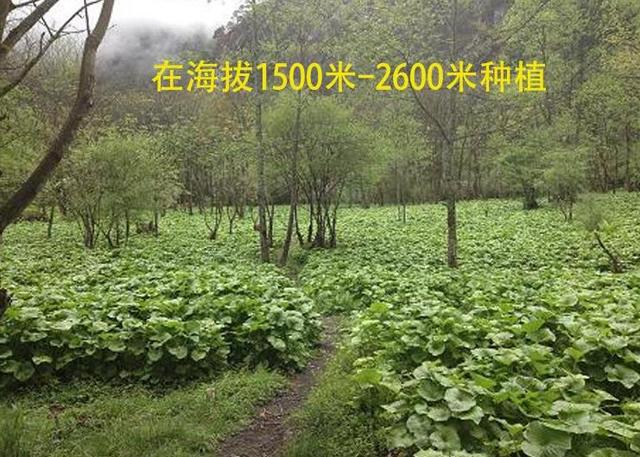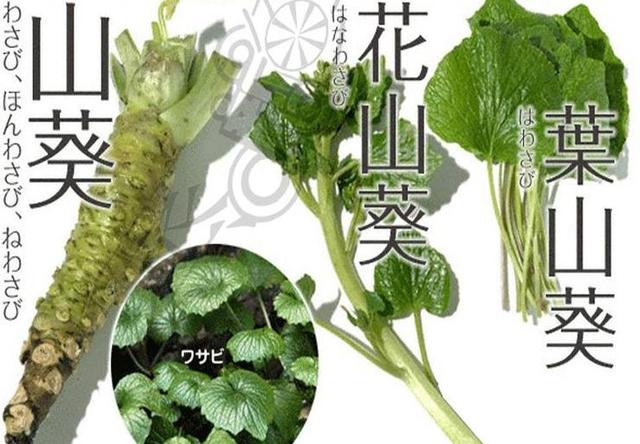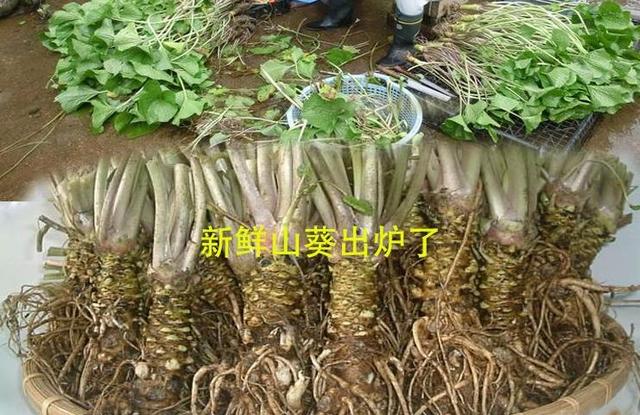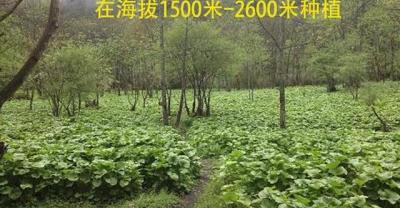Techniques for High Yield Cultivation and Management of Wasabi in Suitable Areas for Wasabi Cultivation
Techniques for high-yield planting and management of wasabi in suitable areas for horseradish planting
1 site selection
Wasabi was planted on the sloping gentle slope between 1 500 ~ 2 600 m above sea level, 5 °~ 15 °, loose and fertile soil, pH 5.9 ~ 7.0. the sandy soil with clean and sufficient irrigation water source was planted.

2 sowing and raising seedlings
Horseradish can be sown locally from September to February of the following year. When sowing and raising seedlings in October, the seedlings emerge quickly, the emergence rate is high, the seedlings are strong, and they can survive the winter in the open field. If the temperature is high when sowing in September, you need to build a shade. When sowing from November to February of the following year, the temperature is low, so it is necessary to raise seedlings in a plastic greenhouse or build a small arch shed. Horseradish seeds are easy to lose their vigor if they lose too much water, so they must be preserved at low temperature. Seeds have a long dormancy period. Before sowing, the seeds need to be treated with 10 mg ·L-1 6-BA or 75% 100 mg ·L-1 GA3, and germinated under the condition of 15 ℃. The germination rate can reach more than 70%. 50% of the seeds can stop sprouting when they germinate and wait for sowing. The 1000-seed weight of horseradish is 8.8 ~ 9.4 g, and the seed amount is 1.5 kg per 667m ~ 2 seedling bed. The plant spacing was 4 cm, the row spacing was 10 cm, and 2-3 seeds were sown in each hole. The length and width of the seedling bed were about 10 m and 1.2 m respectively. 1 hm2 (15 mu) field can be cultivated for every 667m2 seedling area. Or raise seedlings with 2 seeds in each hole and cover the soil with a thickness of 0.5 cm. Horseradish seeds are not tolerant to drought and lose their ability to germinate once they are dry and dehydrated. Water them in time after sowing to keep the soil moist. After 5 ~ 6 months, the seedlings with 3 ~ 4 leaves and a height of 10 ~ 15 cm can be planted in the field.
Horseradish can also be propagated by tillering buds and roots or by tissue culture seedlings. When using tiller buds to propagate, the tiller buds from rhizomes are picked off at harvest for propagation, but tiller buds are easy to carry bacteria (especially black heart disease), resulting in the spread of the disease. When using root propagation, the healthy and sturdy fibrous roots were cut at the time of plant harvest and 5 cm long, and were shallowly buried in the cool forest (or sunshade net) soil in autumn, and the seedlings could be planted in the field after 4 ~ 6 months. It should be noted that tiller buds and roots should be soaked in 70% carbendazim 500 times solution for 15 min before reproduction to reduce the occurrence of diseases.
3 colonization
3.1 soil preparation, fertilization and border making choose deep soil layer (more than 30 cm of tillage layer), fertile sandy soil and continuous cropping of horseradish and cruciferous crops. One month before planting, soil preparation was carried out, 30cm was deeply turned over, and base fertilizer was applied. 2000 kg of mature farm manure, 50 kg of superphosphate, 15 kg of potassium sulfate, 10 kg of urea and 1 kg of boron fertilizer were applied per 667m2. After the fertile soil was turned deeply and mixed, the border was made from top to bottom along the slope, with a width of 70 cm, a width of 40 cm and a height of 40 cm. The border should be tilted to avoid water, not to block the water horizontally, let alone release water along the direction. For plots with a slope greater than 25 °, drainage ditches should be opened above the planting land to prevent mountain torrents from scouring the planting site.
3.2 horseradish can be planted from March to December, but it is best from March to April in spring and from September to October in autumn. If it is planted early to February, it must be covered with an arch shed. High temperature season planting, need to cover the shade net shade. The basic principle of horseradish planting is deep ploughing and shallow planting, and the depth is 5 cm, the root system is not exposed, and the soil cover does not exceed the growing point. After planting, the root water is poured in time, and be careful not to pour down the seedlings. If the whisker root is too long, it can be cut short before planting. Two rows were planted in each border, and the plant spacing was 35,40 cm. The planting method of "product" shape was about 3,500 plants per 667m2.

4 field management
4.1 shading management horseradish growth needs a cool environment, excessive light leaves are easy to burn, yellowing or scorching, thus losing commercial value and affecting economic benefits. Although the summer temperature in Gudui Township, Leibo County is not very high, but the light is strong, wooden piles and other shading sheds should be used to cover the shading net with a shading rate of 60% to 70%. The height of the stake is 2 m, the depth is 20 cm, and the distance between the pile and the pile is 3 m × 4 m. The stake and the pile are connected vertically and horizontally with 10 # iron wire and fixed at both ends to increase the stability. Cement column with specification of 6 cm × 6 cm or steel pipe with diameter of 3 × 5 cm can also be used. The shade shed should be extended from east to west as far as possible, and shade curtains should be set up on both sides of the east and west in the high temperature season. There will be no light from November to March of the following year.
4.2 Fertilizer and water management the first topdressing was carried out about 40 days (days) after spring planting, and the second fertilizer was applied 5 months after 10 kg; per 667m2, that is, in September of the same year, potassium sulfate compound fertilizer (N-P-K = 15-15-15, the same below) was applied for the third time after flower stalks were harvested in March of the following year, and potassium sulfate compound fertilizer was applied for 30 kg per 667m2 The fourth fertilization was carried out in May, and the potassium sulfate compound fertilizer was applied for 50 kg per 667m2, and the whole plant could be harvested in September. During the formation period of horseradish rhizome expansion, 0.2% potassium dihydrogen phosphate can be sprayed for 3 times to promote rhizome expansion.
After planting in autumn, no fertilizer was applied in the same year. The first fertilization was carried out from March to April of the following year, 50 kg potassium sulfate compound fertilizer was applied per 667m2, and a small amount of flowers were removed; if leaves were harvested in May, the second fertilization could be carried out, potassium sulfate compound fertilizer was applied for 30 kg; per 667m2 for the third time in September, and potassium sulfate compound fertilizer was applied for 20 kg per 667m2. The fourth fertilization was carried out in March of the third year, and the potassium sulfate compound fertilizer was applied for 50 kg per 667m2, and the harvest in May or late August was postponed. When applying fertilizer, it should be 10 cm away from the rhizome to prevent black spots from burning the rhizome. Weak seedlings can appropriately increase the times of fertilization to adjust their growth balance.
During the growth period of horseradish, weeds are easy to grow on the ground, so weeds should be artificially weeded 3 or 4 times a year. Pay attention to watering, keep the soil moist, preserve soil moisture in dry season, flood control and drainage in rainy season.
4.3 the main fungal diseases to control horseradish are black heart disease, downy mildew, white rust, root swelling, stem rot, etc., and bacterial diseases are mainly soft rot. In addition, it is also easy to appear the comprehensive symptoms of black rot in the tuber caused by bacteria (soft rot pathogen) and fungi (black rot fungus).
Disease prevention and control should give priority to prevention, comprehensive prevention and control, and rational and scientific use of chemicals. First of all, do a good job in provenance control, do not buy seedlings from disease areas, select disease-resistant varieties, and do a good job in disease prevention at seedling stage. Change the traditional horseradish seedling breeding method, popularize the tissue culture seedling breeding method, cultivate healthy seedlings, and establish disease-free seedling breeding area and production area. The cultivated land should choose the place where the summer temperature is less than 28 ℃, the soil water holding capacity is large and the slope is high. Remove the lower leaves and diseased plant remains of horseradish in time. The diseased plants were excavated in time, and the disease points were closed with lime or chlorothalonil, carbendazim, methyl thiophanate and other agents. As far as possible to avoid continuous cropping, it is appropriate to rotate with Gramineae and legume crops, or interplant light-leaf purple flowers in 6-8 months after horseradish transplanting, and cover them on the border surface after full bloom, so as to improve the micro-ecological environment of horseradish; or implement the off-cropping system.

5 harvesting
The best harvest time for horseradish is March every year. When the bolting length is 8-12 cm, it is picked and sold. The leaves were harvested mainly in May and supplemented in September. When harvested, the sturdy and disease-free leaves with petioles longer than 20 cm were cut together with the petioles, and sold according to the thickness of the petioles. After the rhizome was harvested after 18 months of growth, the whole wasabi was dug up and divided into individual plants, the petiole length was retained for 2 cm, and the fine roots were cut off. After cleaning, the rhizome was packed and sold according to 20g, 30g, 50g, 70g and more than 70g.
Series of planting techniques: vegetable grower ¥8.7 JD.com buys! function () {if (! window.__TEMAI_PARSED) {if (window.vegetable cultivation TEMAIrelevant PARSEDREDIZE) {if (window.responsive.changeScale), window.isPGCrank0parse type = "app" "app") {var e = "% 3Cscript%20src=%22 https://s3.pstatp.com/inapp/toutiao.js%22%3E%3C/script%3E";" Document.write (decodeURI (e))} var t=document.createElement ("script"); t.src = "https://s2.pstatp.com/pgc/v2/pgc_tpl/pagelet/card/click_ccce36d.js",document.body.appendChild(t)}}();"
- Prev

Wang Yuanqin dental implant restoration expert-advantages of dental implants
More and more people are deeply harmed by the loss of teeth, which will bring great changes in life, such as difficulty in chewing, food blockage, pronunciation.
- Next

There is no worry about the sale of growing fruits and radishes, and the growers make a net profit of hundreds of thousands of dollars a year!
We are all familiar with the radish and have eaten it. Radish is crisp and delicious, rich in nutrition, many people like to eat it, but have you ever eaten fruit radish? Tianjin.
Related
- Fuxing push coffee new agricultural production and marketing class: lack of small-scale processing plants
- Jujube rice field leisure farm deep ploughing Yilan for five years to create a space for organic food and play
- Nongyu Farm-A trial of organic papaya for brave women with advanced technology
- Four points for attention in the prevention and control of diseases and insect pests of edible fungi
- How to add nutrient solution to Edible Fungi
- Is there any good way to control edible fungus mites?
- Open Inoculation Technology of Edible Fungi
- Is there any clever way to use fertilizer for edible fungus in winter?
- What agents are used to kill the pathogens of edible fungi in the mushroom shed?
- Rapid drying of Edible Fungi

